Mercedes Alonso
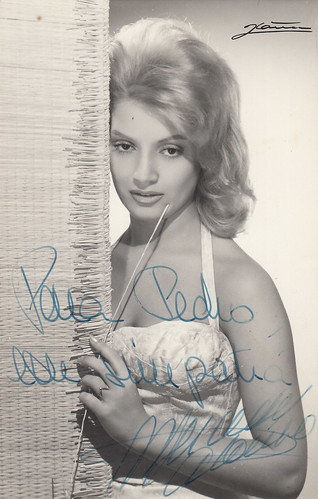
Spanish autographed postcard. Photo: Vicente Ibanez.
Mercedes Alonso (1940) made her screen debut in 1958 and was at the peak of her film career at the beginning of the 1960s. Her most famous role was as a sexy university student in Margarita se llama mi amor (1961), which was a big success at the time. Her other films include El cerra de los locos (1960) and Aqui estan las vicetiples (1961). A few years later, she was featured in several European Westerns such as La tumba del pistolero (1964) and Solo contro tutti/El hijo de Jesse James (1965). Later, she was much more active on stage and on television. For example, she notably played a young and independent artist with whom a lonely and stern septuagenarian falls in love in the episode Adios felicidad (1973) from the popular series Cronicas de un pueblo and had a recurrent role in the well-received Farmacia de guardia from 1991 to 1995.
Margarita Andrey

Spanish autographed postcard. Photo: Vicente Ibanez.
Margarita Andrey (1926) was the daughter of a Spain-based Swiss official. In the mid-1940s, she became a movie star and her films include La mantilla de Beatriz (1946), El verdugo (1948), Mi hijo Veronica (1950), El cerco del diablo (1952), La ciudad de los suenos (1954), Historias de la radio (1955), Nunca es demasiado tarde (1956), … In the mid-1950s, she retired following her marriage.
Maria (Maruja) Asquerino
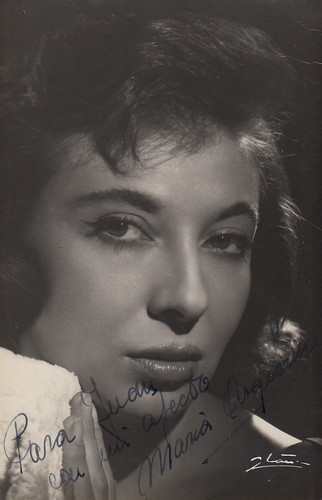
Spanish postcard. Photo: Vicente Ibanez.
Maria (Maruja) Asquerino (1925-2013) had a long and fruitful movie career which began in the 1940s and ended in 2009. She was featured in, for example, Conflicto inesperado (1948), Don Juan de Serralonga (1949), Surcos (1951), Como la tierra (1954), La vida en un bloc (1956), A tiro limpio (1964), De cuerpo presente (1967), Goya, historia de una soledad (1971), Pecado mortal (1977), El gran secreto (1980), Mambru se fue a la guerra (1986), El mar y el tiempo (1989), Fuera de juego (1991), Nadie hablara de nosostros cuando hayamos muerto (1995), Tiovivo c. 1950 (2004), … She also was a brilliant stage actress and was especially praised in 1973 for her performance in Antonio Gala’s 'Anillos para una dama'. She acted in other plays which showed her versatility and her talent, such as Euripides’ 'Hippolytus', Lope de Vega’s 'El caballero de Olmedo' and 'La bella marmaridada', Carlo Goldoni’s 'I pettegolezzi delle donne', Anton Chekhov’s 'The Seagull' and 'Uncle Vanya', Paul Claudel’s 'Le soulier de satin', Eugene Ionesco’s 'Le roi se meurt', Eduardo de Filippo’s 'Filomena Marturano', José Maria Rodriguez Mendez’s 'Flor de otono', etc.
Yvonne Bastien a.k.a. Ivonne de Lys
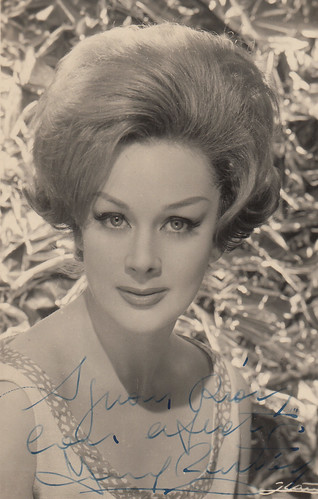
Spanish autographed postcard. Photo: Vicente Ibanez.
Argentinian-born Yvonne Bastien a.k.a. Ivonne de Lys (1933) had a French father and a Spanish mother. From 1945 to 1950, she appeared in several Argentinian films, using at the time the name 'Ivonne de Lys'. She retired following her first marriage in 1952 and, in 1957, remarried with Spanish director Antonio Roman. She settled in Spain and came back to the screen, this time as 'Yvonne Bastien', in 1961. She then starred in several films, mostly directed by her husband, such as La moglie de mi marito/Mi mujer mi gusta mas (1961), El sol en el espejo (1963), Pacto de silencio (1963) and Un tiro por la espalda (1964). Her filmography ended with Antonio Roman’s El meson del gitano (1970), opposite popular singer Peret.
Lina Canalejas
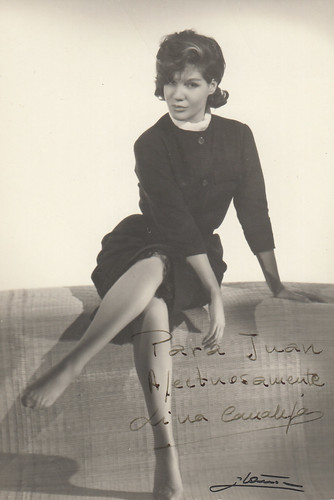
Spanish autographed postcard. Photo: Vicente Ibanez.
After several years of rewarding experience in variety shows, Lina Canalejas (1932-2012) embarked on a brilliant career in theatre from the mid-1950s. She notably got one of her better roles in Jaime Salom’s 'La casa de las chivas'. She also had an interesting filmography. She especially starred in two major works from director Fernando Fernan Gomez, El mundo sigue (1963), which met with censorship problems at the time, and El extrano viaje (1964). She also played a nun called Hermana Vibora (Sister Viper) in Pedro Almodovar’s Entre tenieblas (1983). Her other films include El fenomeno (1956), El secreto de Papa (1959), Mi calle (1960), La prima Angelica (1974), El love feroz (1975), ...
Rocio Durcal

Spanish postcard by Ediciones Tarjefher, no. 221. Photo: Vicente Ibanez.
Rocio Durcal (1944-2006) became a star thanks to her first movie Cancion de juventud (1962), which made the best use of her musical talents. It was followed by other popular musicals such as Rocio de la Mancha (1963), Tengo 17 anos (1964), Mas bonita que ninguna (1965) and Buenos dias, condesita (1967). She played her first dramatic role in Cristina Guzman (1968) and then went back to musicals in Las Leandras (1969) and La novicia rebelde (1972). The dramas Marianela (1972) and Diselo con flores/Dites-le avec des fleurs (1974) were her two first films in which she didn’t sing. In 1977, she played a lesbian in Me siento extrana, a role she regretted to have accepted. She then decided to give up films and to focus on her singing career. She soon specialized in a popular Mexican style of music known as 'ranchera' and became a true icon in that field, selling millions of records.
Ava Gardner

Spanish postcard by Edicolor S.A., Madrid, no. 18. Photo: Vicente Ibanez.
American love goddess Ava Gardner (1922-1990) first came to Spain in 1950 for the filming of Pandora and the Flying Dutchman. She immediately fell in love with that country. In December 1955, she went to live there. In the second half of the 1960s, she somewhat had grown tired of her life in Spain and began to talk about living in London. She settled permanently in England’s capital in 1968.
Katia Loritz

Spanish autographed postcard. Photo: Vicente Ibanez.
Swiss-born Katia Loritz (1932-2015) got her big break opposite Amadeo Nazzari in Manos sucias/La morte ha viaggiato con me (1957). She later starred in Spanish movies such as Las chicas de la Cruz Roja (1958), Mi calle (1960), Atracos a la tres (1962), Trampa mortal (1963), Rueda de sospechosos (1964), … She married in 1966 and, after, El rostro del asasino (1967), she gave up her film career. However, she came back once to the big screen in Pedro Almodovar’s Qué he hecho yo para merecer esto! (1984). In later years, she devoted much time to painting.
Maria Mahor

Spanish autographed postcard. Photo: Vicente Ibanez.
Following a contest, Maria Mahor (1940 ? 1941 ?) was chosen by director Pedro Lazaga for the female lead of Roberto el diablo (1957). The young girl made a good impression on audiences and later starred in other films such as El dia de los enamorados (1959), Melocoton en almibar (1960), Rosa de Lima (1962), Bochorno (1963), Jandro (1965), Clarines y campanas (1966), Los hombres las prefieren viudas (1970), Mecanismo interior (1971), Todos los gritos del silencio (1975), ... In addition to her screen career, she also appeared occasionally in theatre plays. In the first half of the 1970s, she was especially praised as Dona Ines in Jose Zorrilla’s 'Don Juan Tenorio'. Her filmography ended in 1975 and she was thereafter more active on stage.
Marisol

Spanish postcard by Ediciones Tarjefher, no. 121.Photo: Vicente Ibanez.
Marisol (1948) became a hugely popular child star thanks to her first movie Un rayo de luz (1960), followed by, e.g., Tombola (1962) and Marisol rumbo a Rio (1963). In the second half of the 1960s, she matured into a ravishing young lady, without losing the audiences’ favour, and was featured in films such as Las 4 bodas de Marisol (1967) and Carola de dia, Carola de noche (1969). From 1973 on, she turned to dramatic roles and appeared for instance in La corrupcion de Chris Miller (1973), El poder del deseo (1975) and Los dias del pasado (1977). She retired after Caso cerrado (1985).
Maria Martin a.k.a. Mery Martin
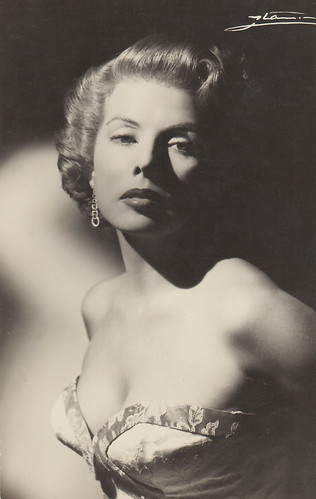
Spanish postcard. Photo: Vicente Ibanez.
Maria Martin (1923-2014) made her screen debut in 1943 and chose to be called Mery Martin. The spelling 'Mery' was uncommon and quite exotic for Spanish audiences. But, in a way, it matched her somewhat Anglo-Saxon blonde looks. She quickly became a star and appeared in Turbante blanco (1944), Culpable! (1945), El angel gris (1947), Cancion mortal (1948), El hombre de mundo (1949), El senorito Octavio (1950), Alba de America (1951), … She also starred in three Italian films: La mano della morta (1949), Capitan Demonio (1950) and Voto di marinaio (1953). But her unusual pseudonym ended up becoming somewhat of a problem. Indeed, on several occasions, she found herself mistaken for American actress Mary Martin. Therefore, from Alta costura (1954) onwards, she decided to become Maria Martin to avoid any more misunderstandings. So, 'Mery' gave way to the much more Spanish-sounding forename 'Maria'. Until the mid-1960s, she still played leading roles in, for example, El ceniciento (1955), Hospital de urgencia (1956), Ya tenemos coche (1958), Parque de Madrid (1959), Cuidado con las personas formales (1962), Crimen (1964), … Later, she was mostly used in supporting parts.
Elisa Montes

Spanish autographed postcard. Photo: Vicente Ibanez.
The granddaughter of famous composer Manuel Penella, Elisa Montes (1934) made her film debut in 1954 and quickly became popular with audiences. Her films include El mensaje (1954), Las ultimas banderas (1957), El aprendiz de malo (1958), Las dos y media y … veneno (1959), La cuarta ventana (1963), El proscrito del rio Colorado (1965), El muerto hace las maletas/Der Todesrächer von Soho (1972), El chulo (1974), Polvos magicos (1979), … On the big screen, she was mostly active from the mid-1950s to the end of the 1970s. She also worked for television and notably appeared in the cast of Verano azul (1981-1982), one of the most successful series ever produced by Spanish TV. It was not only hugely popular in Spain but also in foreign countries such as Portugal or Bulgaria. On stage, Elisa Montes starred in, for example, José Luis Martin Descalzo’s 'Las prostitutas os precederan en el Reino de los cielos' in the 1980s.
Lina Morgan

Spanish autographed postcard. Photo: Vicente Ibanez.
Since the beginning of the 1960s, Lina Morgan (1936-2015) was a major figure in the Spanish entertainment world. Her outstanding comedy skills enabled her to stay at the top for several decades. She was a huge stage star and was especially praised for her variety shows and musicals. Her last one, 'Celeste … no es un color' ran from November 1991 to December 1993. She also performed occasionally in films. For example, from the end of the 1960s to the mid-1970s, she starred in several tailor-made comedies such as Soltera y madre en la vida (1969), La tonta del bote (1970), La graduada (1971), La descarriada (1973), Senora doctor (1974), Las pecados de una chica casi decente (1975) or Un dia con Sergio (1976). Her filmography ended with Hermana, pero qué has hecho? (1995). She too worked to great acclaim for television, notably in the series Hostal Royal Manzanares (1996-1998). From December 2007 to December 2008, she appeared as a guest star in some episodes of Escenas de matrimonio. It was her last acting part.
Conchita Piquer

Spanish New Year Greetings postcard. Photo: Vicente Ibanez.
Conchita Piquer (1906-1990) was discovered in Valencia by famous composer Manuel Penella who, at the beginning of the 1920s, took her to the U.S.A. From November 1921 to January 1922, she performed on Broadway in Penella’s musical 'The Wildcat' and was especially praised for the song 'El florero'. She stayed in the U.S. for several years, appearing on stage and making records for Columbia Company. In 1923, she sang and danced in a sound short film produced by inventor Lee De Forest, using the Phonofilm process. In 1926, she came back to Spain, where she soon became one of the most prominent and popular singers of her time. Her most famous songs include 'La maredeuta', 'En tierra extrana', 'Ojos verdes', 'La Parrala', 'Tatuaje', 'Y sin embargo te quiero', … Several years after her American film debut, she starred in two Benito Perojo’s films, El negro que tenia el alma blanca/Le danseur de jazz (1927) and La bodega (1930). She later was featured in Yo canto para ti! (1934), La Dolores (1940), Filigranas (1949) and Me casé con una estrella (1951), which was filmed in Argentina. She made her last stage appearance in 1958.
Text and postcards: Marlène Pilaete.
No comments:
Post a Comment